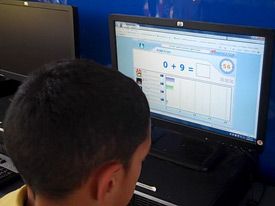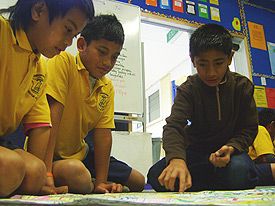How is Mathematics taught at school?

In Years 0 - 2, students work on number knowledge and mathematical strategies;
-
The focus in Year 0-2 is to push their knowledge, so that they see patterning across numbers into the 100’s, really get the number bonds to 5, then 10, then 20, learn numbers before/after, as well as place value;
-
Students should be using a range of counting, grouping, and equal-sharing strategies with whole numbers and fractions;
-
Students should know the forward and backward counting sequences of whole numbers to 100;
-
Students should know groupings within five, within ten, and with ten (eg 10+6=16);
-
Students should be able to communicate and explain counting, grouping, and equal-sharing strategies, using words, numbers, and pictures;
-
Students should be able to generalise that the next counting number gives the result of adding one object to a set and that counting the number of objects in a set tells how many;
-
Students should be able to create and continue sequential pattern
In Years 3 - 8, students follow the Prime Mathematics programme.
PRIME is based on a composite of approaches, used by the top-performing nations in mathematics, and based on Singapore Maths used by over 58 nations globally.
Some of the stated Principles of Teaching used in Mathematics education in Singapore that we follow are:
Principle 1
Teaching is for learning; learning is for understanding; understanding is for reasoning and applying and, ultimately problem solving.
Principle 2
Teaching should build on students’ knowledge; take cognisance of students’ interests and experiences; and engage them in active and reflective learning.
No doubt, many New Zealand schools and teachers also have these principles central to their maths teaching.
The Ministry of Education in Singapore believes that many teachers need support to deliver the curriculum, and acknowledges the role that textbooks play in providing some of the support required. As a result, it assesses all published materials made available to teachers and students in Singapore. It is the way they ensure the integrity of their curriculum is delivered the way they want it to be.
PRIME Mathematics is a collaboration between the Singaporean Ministry of Education and Scholastic. It is designed to give schools outside of Singapore the benefit of the world-class curriculum and teaching/learning experiences used in Singaporean schools.
Teaching Principle 1: Problem solving

“The learning of mathematics should focus on understanding, not just recall of facts or reproduction of procedures. Understanding is necessary for deep learning and mastery. Only with understanding can students be able to reason mathematically and apply mathematics to solve a range of problems. After all, problem solving is the focus of the mathematics curriculum.”
There is no doubt that for many years, New Zealand teachers have been emphasising the critical importance of problem solving. This is not new. Problem solving is at the heart of the New Zealand Curriculum: Mathematics.



